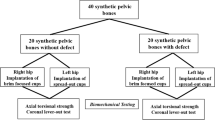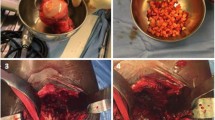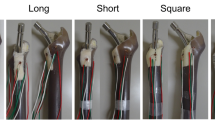Abstract
Introduction
Implant loosening is the most common indication for revision after total hip arthroplasty and is associated with progressive bone destruction. Contained defects can be treated with impaction bone grafting (IBG). Segmental defects are successfully restored with metal augmentation. Considering the increasing number of hip arthroplasty cases in young patients, it would appear sensible to reconstruct the bone stock for future revisions by biological bone defect reduction. The data on the treatment of segmental defects with IBG without additional stabilization are lacking.
Materials and methods
Paprosky type IIB defects were milled into 15 porcine hemipelves with segmental defect angles of 40°, 80° and 120°. Contained defects without segmental defects (Paprosky type I) and acetabula without defects served as controls. After IBG, a cemented polyethylene cup (PE) was implanted in each case. Cup migration, rotational stiffness and maximum rupture torque were determined under physiological loading conditions after 2500 cycles.
Results
Compared with the control without defects, IBG cups showed an asymptotic migration of 0.26 mm ± 0.11 mm on average. This seating was not dependent on the size of the defect. The maximum rupture moment was also not dependent on the defect size for cups after IBG. In contrast, the torsional stiffness of cups with an 120° segmental defect angle was significantly lower than in the control group without defects. All other defects did not differ in torsional stiffness from the control without defects.
Conclusions
IBG did not show inferior biomechanical properties in segmental type IIB defect angles up to 80°, compared to cups without defects.
Similar content being viewed by others
Avoid common mistakes on your manuscript.
Introduction
The greatest challenge in acetabular revision surgery is to achieve sufficient primary stability despite the regular presence of bone defects [1, 2]. Owing to the increasing number of young patients undergoing arthroplasty, an increase in revisions as well as a re-revision burden are to be expected [3]. Without allogeneic reconstructions, bone defects increase with each revision and complicate subsequent re-revision [4,5,Full size image
Biomechanical measurements
The biomechanical load parameters were measured using INSTRON type 8874 H 1003, which is a servo-hydraulic push and pull machine (Fig. 1). It has a measuring range of 10kN for pressure measurements and 100Nm for torque measurements. All 15 porcine hemipelves were clamped in a deflectable vice of the biotesting machine. The biomechanical force was transmitted with the aid of an MRP-TITAN stem implant, prosthetic neck without fin in size S from Brehm, at an angle of approx. 45° to the acetabular plane.
The biomechanical measurement data were processed with the aid of the program FT. StartUP V.7.22.
Pressure analysis
The cup migration was initially determined as a change in path in the sense of a deformation after 1000 cycles and 2500 cycles. Then the difference was calculated from the two values, which reflect the migration of the cup in mm (Fig. 2).
To measure the compressive rigidity, a force of 1500 N was exerted on the pelves in 2500 cycles (1.6 s per cycle), corresponding to two and a half times the body weight of a person weighing 60 kg.
Torsion analysis
This method was used to measure the stiffness, stability and resistance of the 15 porcine hemipelves. A metallic 22 mm femoral head, which was attached to an axial punch, was used to transmit the pressure. This femoral head was bonded to the acetabulum at an angle of 45° using Orthocryl sealing resin (Otto Bock, Duderstadt, Germany). This was followed by 2500 cycles with a constant axial preload of 0.5kN and an alternating torque of ± 0.6 Nm. The torque acting on the acetabulum and the associated angle φ were measured.
Breakout analysis
In the breakout attempt, the PE cup was provoked to break out of the cement layer or the cancellous cement layer by increasing the torque. The maximum breakout moment and the breakout angle were recorded. There was an axial force transmission of a punch with a screwed-on femoral head.
Statistical analysis
The statistical analysis was carried out using SPSS V.19. The measured values were compared in pairs with the control group without bone defects, using the Mann–Whitney U test for independent samples. The level of significance was set at 0.05. Mean values and standard deviations were calculated for all measured values.








